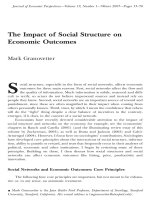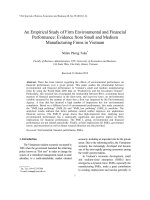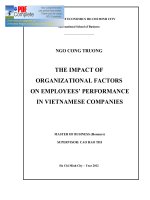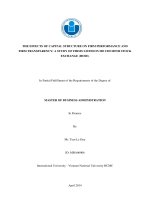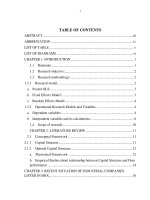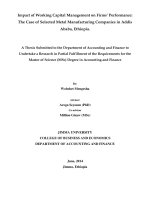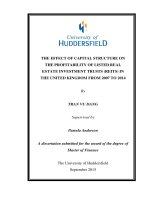Impact of capital structure on firms performance evidence from vietnamese listed companies
Bạn đang xem bản rút gọn của tài liệu. Xem và tải ngay bản đầy đủ của tài liệu tại đây (1.04 MB, 55 trang )
MINISTRY OF EDUCATION AND TRAINING
UNIVERSITY OF ECONOMICS HO CHI MINH CITY
------------
NGUYỄN THỊ HỒNG LOAN
IMPACT OF CAPITAL STRUCTURE ON
FIRM’S PERFORMANCE EVIDENCE FROM
VIETNAMESE LISTED COMPANIES
Subject: Master of Business Administration
Code: 60.34.01.02
MASTER THESIS OF BUSINESS ADMINISTRATION
SUPERVISOR: PGS.TS. PHẠM THỊ THU TRÀ
TPHCM - 2012
Abstract:
Although over the last decades many studies have been conducted to examine the impact
of Capital Structure on Firm’s Performance, but the report results are mixed and the
question of capital structure’s impact on performance still holds well and empirical study
continues, especially in an emergency market like Vietnam where the financial imbalance
occurs in almost business. To answer this question, this study examines the impact of
capital structure on corporate performance in Ho Chi Minh stock exchange, in which we
control the effect of firm’s size, firm’s age, industrial sectors and ownership in the period
2007-2011.
At first the research results show that Vietnamese firms are using an unbalance financial
leverage with a big amount of debt while state controlled use more debt than non state
controlled firm and heavy industry uses more debt than light industry and the difference
is significant. These results are consistent with theories.
An unbalanced panel of 97 companies are studied in this paper and report that a firm’s
capital structure was found to have a significant and negative impact on the firm’s
performance measures in the accounting measures and negative but insignificant in the
market measure – Tobin’s Q. Therefore, it is recommended that Vietnamese firms can
reduce their debt ratio in order to increase profitability.
Control variables: Firm’s age, size, industrial, ownership show mixed results of
relationship with firm’s performance, it may significant or not but with the same trend as
the theories.
Key works: Capital structure, Debt Ratio, Firm’s performance, ROE, ROA, Tobin’s Q,
Gross Profit Margin, Firm’s Age, Firm’s Size, Owner-ship, Different Industries.
1
Statement of original authorship
I declare that this research project is my own work. It is submitted in partial fulfillment of
the requirements for the degree of Master of Business at Institute School of Business,
University of Economics. It has not been submitted before for any degree or examination
in any other University. I further declare that I have obtained the necessary authorization
and consent to carry out this research.
2
Acknowledgments
First and most importantly, I would like to thank my family especially my beloved
husband for their love, support and patience from the beginning of the course to the end. I
could not have made it without them.
Secondly I would like to express my all respects and appreciation to Ms. Pham Thi Thu
Tra my supervisor for her invaluable support, advice and instructions. Having her as a
supervisor greatly assisted in getting to this research done.
I would also like to thank Mr. Nguyen Dinh Tho, who exerts every effort in guiding me
as well as ISB students to implement research.
I would like to thank all my colleagues in VCSC, for supporting me in getting data for the
research.
I also thank to my ISB classmate, for their kindly support and assistance during this last
year.
Last but not least, I would thank management, the faculty and all the staff at ISB for what
they have done to support me as well as my classmate during the course.
Ho Chi Minh City, January 1st, 2013
Nguyen Thi Hong Loan
3
Table of Contents
Abstract:............................................................................................................................... 1
Statement of original authorship ......................................................................................... 2
Acknowledgments ............................................................................................................... 3
List of tables ........................................................................................................................ 6
List of Figures:..................................................................................................................... 6
Abbreviations....................................................................................................................... 7
1
2
Introduction:.................................................................................................................. 8
1.1
Research Background: ........................................................................................... 8
1.2
Research objective ............................................................................................... 10
1.3
Research questions: .............................................................................................. 10
1.4
Outline of the report ............................................................................................. 10
Literature review ......................................................................................................... 11
2.1
Vietnam Economic overview:.............................................................................. 11
2.2
Theory about Capital structure and Firm’s Performance ..................................... 13
2.2.1
Modigliani and Miller’s theory: .................................................................... 13
2.2.2
Trade-off theory ............................................................................................ 13
2.2.3
Pecking order theory ..................................................................................... 14
2.2.4
The information asymmetry and signaling theory: ....................................... 15
2.3
3
The impact of firm’s characteristics: ................................................................... 16
2.3.1
Firm’s Age..................................................................................................... 16
2.3.2
Firm Size ....................................................................................................... 17
2.3.3
Ownership ..................................................................................................... 17
2.3.4
Different industrial sectors ............................................................................ 18
2.4
Empirical evidences ............................................................................................. 19
2.5
Hypotheses development: .................................................................................... 21
Research methodology................................................................................................ 21
3.1
Data collection: .................................................................................................... 21
3.2
Variable of research: ............................................................................................ 22
4
4
5
3.2.1
Capital Structure (Independence Variable) ................................................... 22
3.2.2
Firm’s performance (Dependence variable).................................................. 22
3.2.3
Control variable: ............................................................................................ 24
3.3
Regression Method .............................................................................................. 24
3.4
Model of study: .................................................................................................... 25
3.5
Conceptual framework: ........................................................................................ 26
Results and Discussions .............................................................................................. 27
4.1
Descriptive Statistics ............................................................................................ 27
4.2
Regression ............................................................................................................ 32
Conclusions:................................................................................................................ 34
5.1
Conclusions: ......................................................................................................... 34
5.2
Implication ........................................................................................................... 35
5.3
Limitations and recommendations ....................................................................... 35
Bibliography ...................................................................................................................... 37
Appendix ........................................................................................................................... 40
Appendix A: Final sample selection .............................................................................. 40
Appendix B: DR - GPM regression analysis result ....................................................... 45
Appendix C: DR - ROE regression analysis result ........................................................ 47
Appendix D: DR - ROA regression analysis result ....................................................... 49
Appendix E: DR - Tobin’s Q regression analysis result ................................................ 51
5
List of tables
Table 1: Summary statistics of the explanatory Variables, 2007-2011 ............................. 27
Table 2: Correlation Matrix of the Explanatory Variables, during 2007-2011 ................. 30
Table 3: Correlation Matrix of the Explanatory Variables of Heavy industry during 20072011 ................................................................................................................................... 30
Table 4: Correlation Matrix of the Explanatory Variables of Light industry during 20072011 ................................................................................................................................... 30
Table 5: Correlation Matrix of the Explanatory Variables of state- controlled Company
during 2007-2011 .............................................................................................................. 31
Table 6: Correlation Matrix of the Explanatory Variables of non state-controlled
Company during 2007-2011 .............................................................................................. 31
Table 7: Impact of Capital structure on manufacturing firm’s performance ................... 32
List of Figures:
Figure 1: Total debt to asset in different industrial factor ................................................. 12
Figure 2: The explanatory variable of time, 2007-2009 .................................................... 29
6
Abbreviations
GPM: Gross Profit Margin
ROE: Return on Equity
ROA: Return on Assets
EPS: Earning per Share
DR: Debt ratio
HSX: Hochiminh Stock Exchange
HNX: Hanoi stock Exchange
RE: Random-effects model
FE: Fixed-effects model
SMEs: Small and medium-size enterprises
7
1
1.1
Introduction:
Research Background:
Capital structure decisions play a pivotal role in maximizing the performance of firm and
its valve. Capital structure involves the decision about the combination of the various
source of funds, a firm uses to finance its operations and capital investments. These
sources include the use of long term debt finance, short term debt finance called debt
financing, preferred stock and common stock also called equity financing.
Modigliani and Miller (1958) were the first authors who developed capital structure
theory which suggest that in the perfect capital market financing strategies do not affect
the value of the firm, but later they argue that firm value can be increased by changing
the capital structure because of tax advantage of debts (Modigliani and Miller, 1963). In
recent decades the capital structure has become one of the most interesting issues in the
corporate finance literature. Since then, many researcher followed Modigliani and
Miller’s path to develop new theory on debt policy of firms. However, these attentions
led to develop two main capital structure theories: the static trade-off theory and the
pecking-order theory.
According to the static trade-off theory, an optimal capital structure exists for firm that
can be reached by conducting a balance between benefits (interest tax shields) and the
cost of financial distress (bankruptcy and agency costs) of debts (Myers and Majluf,
1984) Rajan and Zingales, 1995; Wald, 1999; Shyam-Sunder and Myers, 1999; Booth et
al., 2001; Fama and French, 2002; Huang and Song, 2006; Tang and Jang, 2007;
Karadeniz et al., 2009 and Chakraborty, 2010). Using this optimal capital structure, the
value of the firm could be increased due to its lowest cost of capital (Tang and Jang,
2007; Karadeniz et al., 2009).
Myers and Majluf (1984) developed the pecking order theory as an alternative to the
static trade-off theory. Pecking order theory, in contrast to static trade-off theory,
assumes that there is no an optimal capital structure for a firm. According to this theory,
8
since there is an asymmetric information between managers and investors, therefore to
minimize this asymmetric information firms prefer to finance using retained earnings,
debt and equity respectively (Myers, 1984; Myers and Majluf, 1984; Rajan and Zingales,
1995; Wald, 1999; Booth et al., 2001; Fama and French, 2002; Huang and Song, 2006;
Tang and Jang, 2007; Karadeniz et al., 2009; Chakraborty, 2010).
Although over the last decades many studies have been conducted to examine the
superiority of pecking order theory compare to static trade-off theory, but the reported
results are controversial. Fama and French (2002) revealed that none of these theories
would be rejected. Furthermore, Myers (2003) argues that the efficiency of capital
structure theories is based on conditions which are different from one firm to another
(Huang and Song, 2006).
The theories show that the use of financial leverage to grow faster, bringing in higher
profits for shareholders is required. However, in Vietnam, the financial imbalance occurs
in a lot of business in the past years, when the economy fell into difficulties. As Son
(2012) said, the debt-to-equity ratio of local firms is as much as 120%, versus the
regional average of 45%. This is an alarming figure; a ratio of over 60% already poses
risk of bankruptcy if the market developments are unfavorable. The question is whether
the increase of debt influences the financial performance of the business?
As my knowledge, only several such studies have dealt in Vietnam. Of these, San (2002)
focused on a single industry sector (tourism) in a single locality (ThuaThien Hue
Province), whilst Nguyen and Ramachandran (2006) focused on small and medium-size
enterprises (SMEs) only. By contrast, Vu (2003) analyzed companies listed the main
stock exchange. Although they are far less numerous than unlisted companies (most of
the latter are SMEs), listed companies account for a larger share of economic activity.
Therefore, it is important to explore the relationship between capital structure and firm
performance in Vietnamese market.
9
Research objective
1.2
This study aims at examining the relation between Capital Structure which is indicated by
Total debt ratio and the manufacturing Firm’s Performance; including Gross profit
margin (GPM), Return on Assets (ROA), Return on Equity (ROE) and Tobin’s Q over
the period 2007-2011 in Hochiminh Stock Exchange (HSX). Moreover, I will examine
some other factors which have influences on this relationship such as: Firm’s age, Size,
Ownership and Different industries.
So the main objective of this research report is:
-
To examine the nature of relationship between capital structure and firm
performance of listed companies in Vietnam.
-
To evaluate different impacts of capital structure on firm performance with the
different firm’s characteristic.
Research questions:
1.3
This study seeks to provide answers to these questions:
1. What is the impact of capital structure on firm performance?
2. Is there any different impact of capital structure to firm performance in the firm
with different characteristic?
Outline of the report
1.4
This research will be comprises of 5 parts:
-
Introduction: introduce research background, research problem, research
objective and research question.
-
Literature reviews: introduce the Vietnam economic overview and review
theories as well as empirical evident which concern with research to develop the
research hypothesis.
-
Research methodology: introduces research variables and provides general idea
of research process include: method to collect and analyses data, introduces and
reports the research process together with the analyzed results of pilot survey.
10
-
Result and discussion, this part reports the analysis results of panel data as well
as discusses the result finding and connection with theory.
-
Conclusion, to conclude the research finding, includes implication and gives
research limitation as well as provides some further recommendation.
2
2.1
Literature review
Vietnam Economic overview:
After implementing the “Doi Moi” (Reform Policy) in 1986, Vietnam implemented many
reform policies such as equitizatizing the state controlled companies, reforming the
banking system, liberalizing the interest rate, establishing stock markets and opening the
economy to foreign investors. Many laws also have been newly created or revised in
order to support companies in such new environment. Although the financial
environment of the listed companies in Vietnam has improved because of the economic
reform, many problems remain need to be solved. First, in many equitized state
controlled companies, the government remains as a controlling shareholder and still has a
strong impact on the firm’s activities. These companies may have more advantages than
other companies (International Finance Corporation, 2010). Second, although the
functions of the state bank (central bank) and commercial banks are separated, and the
interest rates are liberalized, the five big state controlled or state-controlled commercial
banks lend more than half of the domestic demand. Thus, compared with the other
companies, state-controlled companies may have a priority access to bank loans; such
loans do not necessarily consider economic rationality (Akiba, 2010).
During the hot economy development, the company was borrowing massively from many
different sources. So now, the weighted average debt-to-equity ratio in book value
gleaned from the second quarter financial statements of 647 non-financial companies
listed on the two bourses of Vietnam is among the world’s highest, up to 1.53. This ratio
is so high compared to other economies, both developed and emerging. For example, the
ratio of the U.S listed companies was 1.2 in 2011 and Chinese firms 1.06. Vietnamese
11
businesses have increased financial leverage since 2007. Their debt ratios were already at
high levels in the early 2000s. The ratios of accounts payable to equity of 114 companies
listed on the Hochiminh Stock Exchange averaged out at 1.2 in 2007 (Thanh, 2012). In
this report Thanh also cited the Q2 financial statements of listed firms showing that
construction and real estate are those suffering the highest ratios of debt to equity, at
above 2.0. Non-financial companies have an average ratio of 153%, energy 144% and
consumption goods 80%, the lowest. Remarkably, the ratio of State groups and
corporations reaches over 1.73, higher than the average 1.5 of listed companies in
general.
0
50
100
150
250
207
Construction & real estate(267)
153
Non-financial listed company(647)
144
Energy(43)
Raw material(62)
139
Pharmaceuticals & medical equipment(16)
135
Industrial(71)
134
126
Technology & communication(24)
119
Serivces(71)
105
Agricultural processing(51)
Consumer(42)
200
80
Figure 1: Total debt to asset in different industrial factor
Sharing Thanh’s view, Son (2012) said “The financial weakness of Vietnamese
companies is alarming.” The debt-to-equity ratio of local firms is as much as 120%,
versus the regional average of 45%. This is an alarming figure; a ratio of over 60%
already poses risk of bankruptcy if the market developments are unfavorable (Son, 2012)
12
2.2
Theory about Capital structure and Firm’s Performance
Modigliani and Miller (1958) is a natural starting point for an analytical understanding of
capital structure. All research that have followed study various forms of deviations from
their idealized setting with fully symmetrical information, no taxes, no bankruptcy costs,
exogenous cash-flows, and efficient markets in all assets. Myers (1984) defines the two
main competing theoretical directions; “Trade-off theory” and “Pecking order theory”.
2.2.1
Modigliani and Miller’s theory:
Since Modigliani and Miller published their seminal paper in 1958, capital structure has
generated great interest among financial researchers. They argued that in efficient
markets the debt-equity choice is irrelevant to the value of the firm and benefits of using
debts will compensate with decrease of companies stock. Prior to MM theory,
conventional perspective believed that using financial leverage increases company’s
value. In this respect, there is an optimized capital structure that minimizes capital costs.
In a subsequent paper, Modigliani and Miller (1963) eased the conditions and showed
that under capital market imperfection where interest expenses are tax deductible, firm
value will increase with higher financial leverage. Models based on impact of tax,
suggest that profitable companies should have more debts these firms have more need for
tax management in corporation’s profit. However, increasing debt results in an increased
probability of bankruptcy. Hence according to this theory, the firm with higher debt
should perform better, but that level of debt has to balance bankruptcy costs and benefits
of debt finance.
2.2.2
Trade-off theory
Trade-off theory assumes that firms optimally balance the costs of debt, e.g., distress risk
and bankruptcy frictions with the benefits, typically tax savings, but also management
discipline and optimal scale. Firms are expected to move towards target leverage and
does their marginal financing accordingly, although time their transactions due to costs of
adjustments. In a dynamic setting, firms see their targets develop over time and consider
13
today’s adjustments through new financing or payouts also in light expected future
optimal leverage.
Agency issues are relevant in any financing discussion and the seminal paper is Jensen
and Meckling (1976). They develop a theory based on agency costs in structures with
separation between ownership and management and as well as outside lenders. They
postulate that conflicts between shareholders and managers occur since managers hold
less than one hundred percent of the residual claim. In these case, because ownership
(shareholders) and control (management) of firms lies with different people, managers
are not motivated to apply maximum efforts and are more interested in personal gains or
policies that suit their own interests and thus results in the loss of value for the firm and
harm shareholders interests. Therefore, debt finance act as a controlling tool to restrict the
opportunistic behavior for personal gain by managers. It reduces the free cash flows with
the firm by paying fixed interest payments and forces managers to avoid negative
investments and work in the interest of shareholders. So according to this theory, the firm
with higher debt should perform better.
Agency problems are one of the reasons why the pecking order theory predicts that
outside capital is more expensive.
2.2.3
Pecking order theory
Pecking order theory predicts that due to the information asymmetry between a firm and
outside investors regarding the actual value of both current operations and future
prospects, outside capital will always be relatively costly compared to internal funds and
equity more so than debt. Outside investors will, as described by Akerlof (1970), require
a compensation for their expected informational disadvantage.
Myers and Majluf (1984) argue that information asymmetry will lead to a mispricing of a
firm’s equity in the marketplace. Aware of the resulting dilution of current shareholders’
actual values, firms may not raise new equity even for projects with positive net present
values, often denoted the “under-investment problem”. They predict that firms will
14
choose to finance new investments in ways which minimize this problem and thus avoid
new equity issues.
Myers (1984) extends this theory into a ’pecking order’ theory of financing. This theory
predicts that the existence of asymmetric information will lead a firm to firstly use
retained earnings and funds from current owners, then risk-free debt and finally risky
debt before eventually raising new equity from outside investors.
A development in this area, Halov and Heider (2004), takes a more sophisticated
approach to the issue of asymmetric information by separating uncertainty from risk. The
paper is primarily empirical, but novel in that they find that firms prefer to issue equity
when risk matters relatively more and debt otherwise. Their argument is that by issuing
equity rather than debt, risky firms avoid the adverse selection costs of debt. Berger and
Udell (1998) apply a related approach to the issue of credit availability for small- and
medium sized companies, discussing how the opaqueness of firms impacts the relevant
lending assessment technology.
Pecking order theory predicts marginal financing flows, but has no views as to overall
optimal capital structure. It is hard not to assume that extremely high or low leverage will
have to impact marginal financing, but this is outside the pecking order theory.
2.2.4
The information asymmetry and signaling theory:
The information asymmetry theory of capital structure is credited to the work of Ross
(1977).
He posits that firm managers possess more information about the future
prospects of the firm than the market.
Therefore management’s choice of capital
structure may provide the market with signals of a firm’s future prospects. Increasing
leverage would signal to the market that a firm’s managers are confident about servicing
the interest charge, and are hence confident about the future prospects of the firm.
Therefore an increase in leverage would increase the value of the firm since investors
would deem this to be a positive signal of the size and stability of future cash-flows.
15
Fama and French (1988) disagreed with this notion, arguing that more profitable firms
tend to have lower levels of debt. In this case increasing debt would signal poor future
prospects for the firm, since future earnings will be impacted negatively due to cash flow
being used to service debt, reducing the amount or money available to fund future
development. Raju and Roy (2000) establish that the value of available information
contributing to firm profitability is higher for larger companies and is higher for Different
industries sectors where there is intense competition. Therefore the release of credible
information by managers affects the performance of a firm and has an impact on the
perceptions held by the external market about a firm.
2.3
The impact of firm’s characteristics:
A number of firm level characteristics have been identified in previous empirical
research. Recent papers on dynamic capital structure include Fischer, Heinkel, and
Zechner (1989), Goldstein, Ju and Leland (2001) and Hennessy and Whited (2005). Most
of this literature assumes a firm scale and that product markets and cash flows as
exogenous, disregarding any interaction between leverage and operations. An example of
the opposite is Maksimovic (1988) who shows that a firm’s debt capacity is a function of
Different industries and firm characteristics, e.g. elasticity of demand and discount rate.
In this research I review impact of firm’s size, firm’s age, different industries and
ownership.
2.3.1
Firm’s Age
Age could actually help firms become more efficient. Over time, firms discover what
they are good at and learn how to do things better (Arrow, 1962; Jovanovic, 1982;
Ericson and Pakes, 1995). They specialize and find ways to standardize, coordinate, and
speed up their production processes, as well as to reduce costs and improve quality. The
relevant literature goes back to Smith and Ricardo. Old age, however, may also make
knowledge, abilities, and skills obsolete and induce organizational decay (Agarwal and
Gort, 1996 and 2002). One possible reason is that success induces firms to codify their
approach through organization and processes, a regulation that can become capillary over
16
time. This behavior seems increasingly to entangle firms in structural and process-related
rigidities that are difficult to discard (Leonard-Barton, 1992)and that could cause
companies to succumb to Schumpeter’s “perennial gale of creative destruction.”
It could also be that older firms are incapable of solving collective action problems. As
in the case of nations (Olson, 1982), firms might increasingly become organizations of
rent-seeking factions as they get older. On balance, it is therefore unclear whether aging
helps firms prosper or whether it dooms them.
From the above contributions, a firm’s age is expected to have a positive influence on a
firm’s performance.
2.3.2
Firm Size
The size of a firm affects performance in many ways. Key features of a large firm are its
diverse capabilities, the abilities to exploit economies of scale and scope and the
formalization of procedures. These characteristics, by making the implementation of
operations more effective, allow larger firms to generate superior performance relative to
smaller firms (Penrose, 1959). Alternative points of view suggest that size is correlated
with market power (Shepherd, 1986), and along with market power x-inefficiencies are
developed, leading to relatively inferior performance (Leibenstein, 1976). Titman and
Wessels (1988) assert that larger firms are more diversified and are therefore less
susceptible to bankruptcy than smaller firms. Rajan and Zingales (1995) also hold that
there is a positive relationship between firm size and leverage. Although, theory is
equivocal on the precise relationship between size and performance, it’s more likely a
firm’s size is expected to have a positive influence on firm’s performance.
2.3.3
Ownership
There are many listed companies of which the government became the controlling
stockholder and influenced company activities after state-owned companies were State
controlled. These companies are defined as state-controlled companies, which have closer
relations with state-owned banks than other companies and state-owned commercial
17
banks may not be normal external creditors of state-controlled companies, and their
monitoring activities may be less stringent toward state-controlled companies. These
accords with Nguyen and Ramachandran (2006), who pointed out those state-owned
enterprises in Vietnam tend to receive more favorable treatment from state-owned
commercial banks which represent the bulk of the banking sector.
With regard to government ownership influences on firm performance, literature
suggests that governments are likely to pay attention to political goals such as output
prices and employment highlighting the fact that government ownership are
nonprofit-maximizing owners and are therefore expected to be low performers in
terms of conventional performance measures (Laffont and Tirole 1993; Shleifer and
Vishny 1997). From these arguments, it’s expected a different relationship between
capital structure and performance of the firm with difference ownership.
2.3.4
Different industrial sectors
Schwartz and Aronson’s (1967) research concludes that the capital structures of firms in
different industries are different from each other. They infer that capital structure in an
Different industries is influenced by operational risk and asset structure. They also
indicate that the capital structure in specific Different industries sectors over time is
dynamic, given a firm’s pursuit to maximize value. Barclay, Smith, and Watts (1995)
find that leverage is high for regulated firms and firms in low-tech industries, and is low
in high-tech industries.
Jensen and Meckling (1976) state that industries in which
opportunities for asset distribution are more limited, will have higher levels of debt.
Therefore, the industries sector is expected to have an impact on corporate performance
also.
18
2.4
Empirical evidences
The empirical evidences on the relationship between firm performance and capital
structure have produced mixed results:
Some empirical studies have been found a positive relation between financing choices
and firm performance: Roden and Lewellen (1995) examines the capital structure of 48
US firms during the period 1981-1990 and revealed a positive relation between
profitability and capital structure. Similar results were documented by Champion (1999)
and Gosh et al. (2000). Hadlock and James (2002) suggest corporations with high level of
profitability use high level of debts. In the other words, they show a positive relation
between performance and capital structure. Abor (2005) reports a positive relation
between capital structure, which measured by short-term and total debt, and performance
over the period 1998 -2002 in the Ghanaian firms. Berger and Bonaccorsidi Patti (2006)
provide the same results. Finally, Arbabiyan and Safari (2009) investigate the effects of
capital structure on profitability using 100 Iranian listed firms from 2001 to 2007. They
found short-term and total debts are positively related to profitability (ROE) while
indicate a negative relation between long-term debts and ROE. Saedi and Mahmoodi
(2011) examine the relationship between capital structure and firm performance. The
study uses four performance measures (including ROA, ROE, EPS and Tobin’s Q) as
dependent variable and three capital structures (including long- term debt short –term
debt and total debt ration) as independent variable. The study indicated that firm
performances, which is measured by EPS and Tobin’s Q, is significantly and positively
associated with capital structure, while reported a negative relation between capital
structure and ROA, and no significant relationship between ROE and Capital structure.
By contrast, several scholars revealed a negative relation between capital structure and
firm performance. In this line, Kester (1986) found a negative relation between capital
structure and performance (profitability) in the US and Japan. Similar results were
reported by Friend and Lang (1988), Titman and Wessels (1988) from the US firms,
Rajan and Zingales (1995) in the G-7 countries, Wald (1999) in the developed countries.
19
In addition, Wiwattanakantang (1999) reported a negative relation between book and
market leverage and ROA from 270 Thai firms. Huang and Song (2006) found a negative
correlation between leverage and performance (earnings before interest and tax to total
assets) in the China firms. Booth et al. (2001), Chiang et al. (2002), Chen (2004),
Deesomsak et al. (2004), Karadeniz et al. (2009) indicate the same findings. Research
Pratheepkanth (2011) analyzed the capital structure and its impact on financial
performance capacity during 2005 to 2009 of Business companies in Sri Lanka. The
results shown the relationship between the capital structure and financial performance is
negative. One of the most recent, Abul (2012) in his study of the engineering sector of
Pakistan show that financial leverage has a significantly negative relationship with the
firm performance measured by Return on Assets (ROA), Gross Profit Margin (GPM) and
Tobin’s Q. The relationship between financial leverage and firm performance measured
by the return on equity (ROE) is negative but insignificant. Asset size has an insignificant
relationship with the firm performance measured by ROA and GPM but negative and
significant relationship exists with Tobin’s Q
Several studies show either poor or no statistical relation between capital structure and
performance (Tang and Jang, 2007; Ebaid, 2009). Ebaid (2009) investigates the impact of
capital structure choice on performance of 64 firms from 1997 to 2005 in the Egyptian
capital market. He employs three accounting-based measures; including ROA, ROE and
gross profit margin, and concludes capital structure choices, generally, has a weak-to-no
impact on firm performance.
Tran Dinh Khoi Nguyen and Neelakantan Ramachandran10 (2006), conducted a study
titled “Capital Structure in Small and Medium-sized Enterprises: The Case of Vietnam”.
It was found that firm size and level of business risk have a significant and positive
relationship with all measures of capital structure. The stronger its relationship with a
bank becomes, the larger the amount of bank loans an SME can obtain to finance
operations
20
In summary, the results of examining the relationship between financing choices and
performance are mixed and the question of capital structure’s impact on performance still
holds well and empirical study continues.
2.5
Hypotheses development:
According to almost theories I mention above include: MM theory, Trade-off theory,
Pecking order theory, The information asymmetry and signaling theory the firm with
higher debt should perform better, but that level of debt has to balance bankruptcy costs
and benefits of debt finance because an increase in debt level will also increase the
probability of the firm’s bankruptcy. While in some last years, Vietnamese firm’s debt
ratio is in an alarming situation (Son, 2012), so I expect a negative relationship between
leverage (DR) and firm performance. The following hypothesis will be tested:
H1: A firm’s capital structure (Debt ratio) has a negative and significant impact
on its Gross Profit Margin.
H2: A firm’s capital structure (Debt ratio) has a negative and significant impact
on its Return on Equity.
H3: A firm’s capital structure (Debt ratio) has a negative and significant impact
on its Return on Asset.
H4: A firm’s capital structure (Debt ratio) has a negative and significant impact
on its Tobin’s Q ratio.
3
3.1
Research methodology
Data collection:
The sources of data for this study come mainly from a number of secondary sources,
mostly online, including the Hochiminh Stock Exchange. Extensive use has been made of
annual reports and financial statements. This study is based on the financial data
from 2007 - 2011 of firms which were listed in Hochiminh stock Exchange (HSX)
before 30-12-2007.
21
Our data set include the data of 96 manufacturing companies in 5 years, which were
classified in two ways:
-
Different industries: include Light industry and Heavy industry.
-
Ownership: here only mention state-controlled companies and others which will
be named non state controlled companies.
The data only available when that company was listed, so we can take all the data for 96
companies in 2011, but the companies’ data available in 2010, 2009, 2008, and 2007 are
93, 83, 71 and 49, respectively.
3.2
3.2.1
Variable of research:
Capital Structure (Independence Variable)
There are various measures of leverage, which can be classified as accounting based
measures, market-value measures and quasi-market value measures. The literature shows
a number of measures of capital structure such as Abor (2005 and 2007) and Ebaid
(2009) used the three (short term, long term and total debt) to total assets as measures of
financial leverage.
In this study I use the most important measure of capital structure: The Debt ratio, which
is defined as total debt divided by total equity:
3.2.2
Firm’s performance (Dependence variable)
The most commonly used performance measure proxies are gross profit margin (GPM),
return on assets (ROA) and return on equity (ROE). These accounting measures
representing the financial ratios from balance sheet and income statements have been
used by many researchers such as: Gorton and Rosen (1995), and Ang, Cole and Line
(2000), Kuben Rayan (2008), Ebaid (2009), Arbiyan and Safari (2009), Saedi and
Mahmoodi (2011), Abul (2012)…)
22
Besides that, there are other measures of performance called market performance
measures. One of these measures which used to measure firm's value in many studies is
Tobin’s Q (McConnel and Serveas (1990), and Zhou (2001), King & Santor (2008),
Saedi and Mahmoodi (2011), Abul (2012)…).
So that, the proxy for firm performance in this study is: GPM, ROE, ROA and Tobin’s Q.
The gross profit margin (GPM) is a measure of the gross profit earned on sales. The
gross profit margin considers the firm's cost of goods sold, but does not include other
costs. It is defined as follows:
Return on assets (ROA) is a measure of how effectively the firm's assets are being used
to generate profits. It is defined as:
Return on equity (ROE) is the bottom line measure for the shareholders, measuring the
profits earned for each dollar invested in the firm's stock. Return on equity is defined as
follows:
Tobin’s Q was introduced by Tobin as an appropriate performance measure in 1969 and
is defined as follows:
23
3.2.3
Control variable:
As mentioned in the Hypothesis development, I examined the impact of four controlled
variable: Firm size, Firm Age, Ownership and Different industries sector:
-
Age: The number of years since the inception of the firm to the observation date.
-
Size: Natural logarithm of total assets.
-
Ownership: the state-controlled takes the value 1 and the other takes value 0.
-
Different industries sector: The dummy variable takes the value 1 if the firm is
Light industry (Include: Beverage, Food product, Farming & Fishing, Clothing &
Accessories) and Heavy industry (Include: Heavy Construction, Steel, Specialty
Chemicals, Furnishings, Building Materials & Fixtures, Electrical Components &
Equipment, Pharmaceuticals & medical equipment) takes the value 0.
3.3
Regression Method
Because of the nature of data set, in which variable change over time so panel data
methodology is adopted, and the useful software for panel data analysis, STATA were
used in this study. Besides that, we need to control the effect of ownership and different
industries sectors– the time invariant variables, which are absorbed by the intercept in the
fixed effects model (Kohler, Ulrich, & Kreuter, 2009) so the Random effects model may
be chosen. On the other hand, the underlying assumptions of random effects model is that
the εi is a random drawing from a much larger population (Gujarati, 2003), while in this
case, we take all the manufacturing companies in HSX, so suppose that it’s a random
sample is not tenable.
From the arguments, in order to analyze the impact of Capital structure on Vietnamese
firms’ performance we should test respectively three methods:
Pooled regression model: In this model, approach is to disregard the space and time
dimensions of the pooled data and just estimate the usual OLS regression. That is, stack
24
